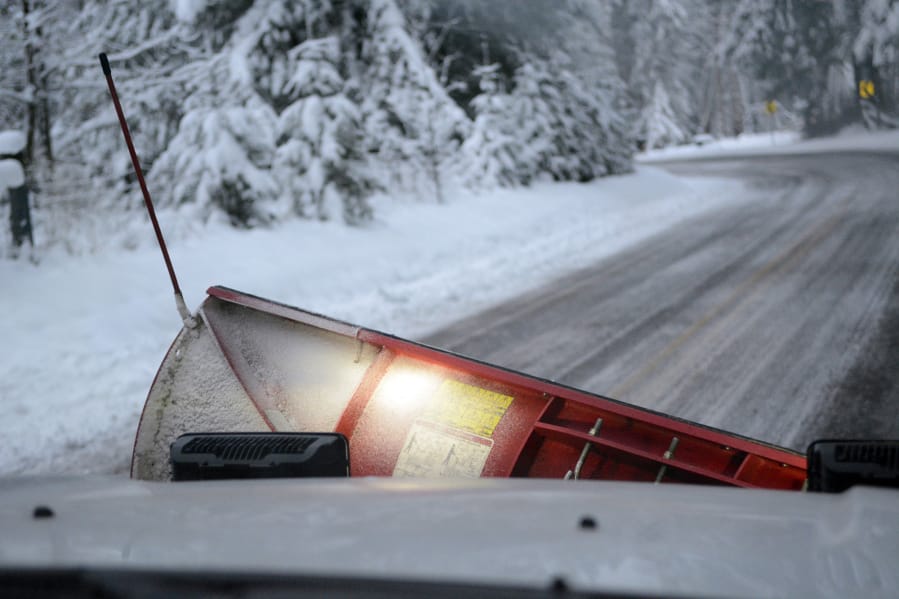VIEW — Even looking through the dirty windshield a snowplow noisily scraping along, the little community of View in unincorporated Clark County lived up to its name at sunrise on Thursday.
Rows of evergreen trees, whose branches drooped under the weight of fresh snow, lined the edges of expansive white hilltop prairies. At one farmhouse, a couple black dogs zoomed along the fence, trying to keep pace with the big truck Nick Eiesland was driving. Snowy white mountains loomed high in the distance.
The scenery is one of the perks of the job while cleaning up after a big storm for the Clark County Public Works snowplow drivers.
While many drivers in Southwest Washington might feel a creeping sense of dread when the snow begins to fly, county road crews get pumped.
“These storms make it easy to work these hours because it’s something different,” Eiesland, a road maintenance crew chief, said around 6 a.m., near the end of his 12-hour night shift running a county plow. “It’s exciting. A lot of these guys would probably do — well, at least the first day for free.”
The snow only sticks around for a few days out of the year in this part of the country (if it even snows at all). But when it does it’s extremely disruptive for the county’s roughly 460,000 residents. So when it starts to fly, plow operators are out, tending to the county roads with salt, sand and plows, often when most of us are still asleep or the early risers are just rolling out of bed.
Plowing in town isn’t exactly easy; drivers have to worry about obnoxious drivers, bad traffic, curbs and the occasional protruding manhole. But in the country, things can get downright harrowing sometimes.
“You’ve got a lot of steep hills with no guardrails and canyons,” Eiesland said. “Everybody’s slid down a hill backwards when you’re working out in these areas. That’s not a fun feeling, especially when you’re in a 50- to 60-thousand-pound truck, sliding backwards, out of control.”
Last winter, when the Vancouver metro area got about a foot of snow in one storm, Eiesland was one in a line of plows five across at 3 a.m. that scraped Highway 99 in one fell swoop.
“That’s moving a lot of snow at one time,” he said.
This winter, on the other hand, has been pretty balmy by most standards, but drivers have had their hands full dealing with three different snowstorms since the start of the week. The storm that hit Wednesday night and early Thursday morning largely spared the lower elevations of the county, thanks to relatively high temperatures. Still, some reaches of the northern county saw several inches of snow pile up. After the busiest roads were cleared up, Eiesland spent the latter part of his shift clearing and sanding the steep, windy roads east of La Center and north of Battle Ground.
“People out in the country understand they’re not the first on the list,” he said. “So sometimes they’ll do what they have to do — that’s the difference out here (compared to in town), you’ll see a lot of guys out here with tractors taking care of their own and some of the smaller roads.”
Unincorporated Clark County has more than 2,600 lane miles — enough to drive from Vancouver to Atlanta, Ga. — but about 1,250 of those lane miles are the primary and secondary plowing priorities. Cleaning up after any given snowstorm might mean about 30 county plow drivers are out on the roads working in 12-hour shifts. Plows are only used to sand and salt potentially dangerous areas, like steep hills or corners, to make best use of the material and their time. Otherwise, plow drivers would spend a lot of their working hours driving back and forth to refill their sand supply.
Crews also keep a close eye on school district bus routes and an ear out for any schedule changes districts might make when it snows. If schools let students out early, the snowplow drivers want to get the roads and bus turnarounds cleared well in advance.
But even when a snowplow does clear the roads, drivers shouldn’t expect to travel as if it were an afternoon in July.
“It’s still going to be slippery, you’re still going to have to drive slow, have traction devices,” Eiesland said.




